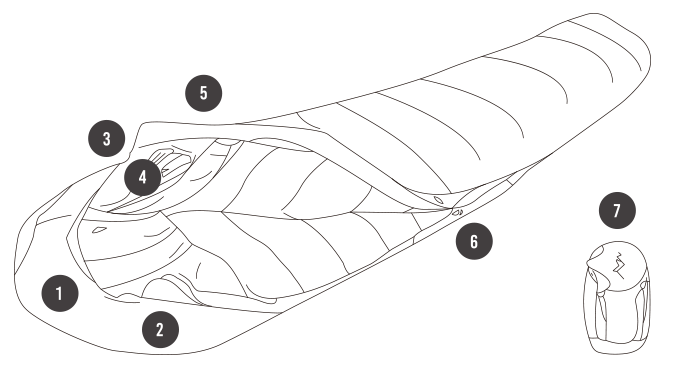PRODUCT MAINTENANCE
AND USE FOR FOOTWEAR
Tie the footwear well to avoid that the end of the fingers hit against the internal face of the end. In descents, our feet usually go away towards ahead and the end of the toes probably hit against the internal part of the end. They can be very uncomfortable and produce injuries.
Once the foot is in the boot, it is suitable to give blows with the end of the heel against the ground so that the feet go away towards the back part of the boot, and once are there, proceed to adjust the cords in the zone of instep so that they hinder the displacement forwards.
If we apply horse fat, waxes, or silicones to the boot Altus, we will be closing pores of the structure of the skin and the lining, and will be making the boots more impermeable, but they will not breath and the feet will finish
For a correct breathability it is also important the type of socks we use. If we use socks made of wool, natural cotton or other fibers they will retain the sweat and we will have humidity.
ADVICES FOR
THE MAINTENANCE
After its use, let air them and dry the humidity in a natural form, in the shade and room temperature. Do not approach to radiators, stoves or chimneys because the skins will dehydrate and become stiff, cracking themselves by the zones of flexion.
Eliminate the inner humidity filling up the boot with newspaper. When they are dry, brush them to retire the accumulated dirt mud. Clean them with a wet cloth and let dry again.
HOW TO SELECT A SLEEPING BAG
Isolation capacity and comfort temperature in a sleeping bag depends on three main features:
1. QUALITY OF THE RAW MATERIAL
Among the raw materials, the most important is the filling, being the one that is able to maintain more heat. There are filling of down and polyester fiber. The first, when it has a high percentage of down (90% down, 10% feather) and a high weight, has a better calorific yield whereas the polyester fiber has low maintenance and long life.
2. STRUCTURE AND DESIGN
As the sleeping bag is structured according to the standard pro le of the people (mummy type), the bag would isolate better and if it has side partitions it will distribute evenly the hot air around the user.
3. SIZE OF THE USER
The person’s complexion will modify the comfort temperature of a sleeping bag in a substantial way. The human body is a heat generator with a constant temperature of 36o ±1o. A small person would occupy less volume inside the bag and so there would be a larger volume of air to warm up. A medium/big complexion person would occupy a larger volume insi- de the bag and so, not having an excessive volume, this would reach higher temperature. A very big complexion person would leave little air volume to warm up so it couldn’t be warmed up before this has escaped to the outside.
NOTE: The user, according to their own complexion, can select the sleeping bag which they require paying attention to the temperatures which the Manufacturer certifies under official laboratories essays.
4. TEMPERATURE
The hot air inside the bag, due to the human body temperature, escapes to the outside, being renewed by denser cold air than former one. Bag structure and size of the person influence the speed of warming up and of cooling in a continuous convection process.
Technical features
- Ergonomic headrest
- Thermal collar
- Elastic cords with cord locks
- Inside pocket
- Lapel protecting the zipper
- Zipper protection
- Compression bag

CARRYING A BACKPACK CORRECTLY
It is important to pack the equipment correctly. All items must be packet in their correct sequence.Heavy articles, like tents, should be placed near the back.
The heaviest materials must be placed near your back and the lightest at the top.
ADJUSTMENT OF THE BACKPACK
- The starting point of the shoulder strap should be about 5 to 7 centimetres to the middle of the neck.
- Pull for fixing the hipbelt.
- Pull for fixing the shoulders straps.
- Pull for fixing the chest strap.
- Adjust the buckle till meeting shoulder line.
- Pull for fixing upper weight.
- Pull for fixing lower weight, under hip belt.
Adjustment will depend on every model.

WASHING SLEEPING BAGS
The best advice to keep your sleeping bag clean is to use a sleeping bag liner. This way, you can delay or minimize washing the bag. However, when you need to wash it, follow these instructions.
MAINTENANCE FOR SYNTHETIC FIBER BAGS
Machine Washing
- Use a detergent specifically for synthetic sports fibers. Never use fabric softener.
- Close all zippers and turn the bag inside out.
- Use a gentle cycle at a maximum temperature of 40ºC and select an extra rinse.
- Roll the bag to remove excess water before taking it out of the drum.
Tumble Drying
- Roll the bag and place it in the dryer.
- Use the low or "delicates" setting.
- Turn it inside out and repeat the cycle.
- Air it out for 48 hours before storing it.
Air Drying
- Lay the bag flat between two towels in a horizontal position.
- Ensure it is completely dry before storing it.
These tips will help you keep your synthetic fiber sleeping bag in good condition for longer.
MAINTENANCE FOR DOWN SLEEPING BAGS
Hand Washing
- Never use fabric softener.
- Use a specific down soap.
- Fill a bathtub with warm water and turn the bag inside out.
- Gently massage and change the water several times.
- Rinse until the water runs clear without foam.
- Remove excess water without wringing.
- Dry flat, moving it occasionally.
Machine Washing
- Never use fabric softener.
- Turn the bag inside out and close zippers and velcros.
- Use a delicate cycle at less than 40ºC with extra rinse.
- Remove excess water before taking it out.
- Dry in a dryer with balls to avoid clumping, using a delicate program and low level.
What Not to Do
- Do not use dry cleaning or dry cleaning products.
- Do not use fabric softener.
- Do not store the bag wet to avoid mold.
These tips will help you keep your down sleeping bag in good condition for longer.

